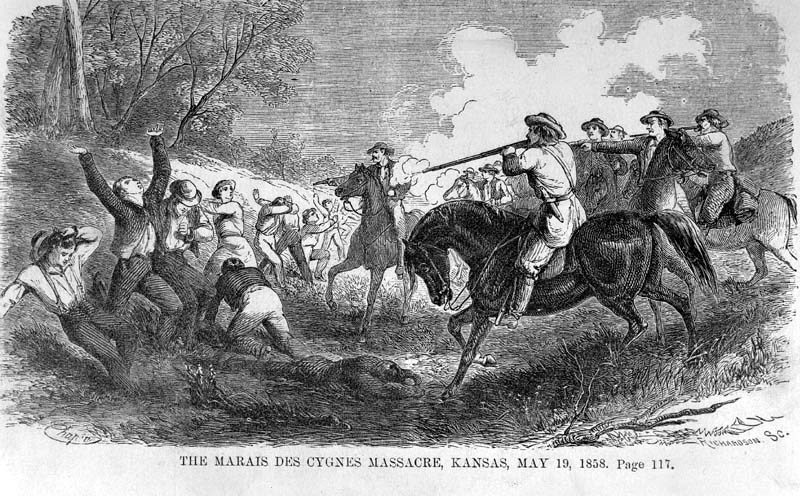By Chris Rein, Combat Studies Institute, Army University
Event Summary:
- Date: May 19, 1858
- Location: Near Trading Post, Linn County, Kansas
- Adversaries: Proslavery Missouri border ruffians vs. Free-Staters
- Casualties: Five of 11 Free-Staters killed, one wounded
- Result: Massacre of five Free-Staters
On May 19, 1858, proslavery “border ruffians” led by Charles Hamilton rounded up a number of suspected antislavery men near the town of Trading Post in modern Linn County, Kansas. After releasing some of their prisoners, the Missourians marched 11 men into a secluded ravine and opened fire on them, killing five and seriously wounding five others before escaping back across the border into Missouri. Although attacks and reprisals continued until the outbreak of the Civil War, the Marais des Cygnes Massacre was the last major violent episode of the “Bleeding Kansas” period.
Charles Hamilton, a Georgia native who had moved to Kansas to help hold the territory for the proslavery forces, was, by 1858, a veteran of several skirmishes along the border. In May, antislavery forces led by James Montgomery besieged Hamilton’s fortified house, causing him to leave the territory, but he resolved to return and take revenge on his former neighbors. After rallying a party of 25 men in Missouri, Hamilton returned to the Marais des Cygnes River Valley, robbing and taking prisoner any men suspected of antislavery sentiments. Most were captured at their homes or while working their fields and had little opportunity to escape, but Eli Snyder, a blacksmith, fired on his attackers and, though wounded in the leg, managed to escape.
The six survivors also fell to the ground and feigned death, only one of them unwounded.
After releasing those prisoners who were aged, young, or fellow freemasons, Hamilton’s gang marched the remaining 11 to a secluded ravine roughly three miles northeast of Trading Post and less than a mile from the Missouri border. Here Hamilton ordered his prisoners to form a line and face their captors. Although some of Hamilton’s men evidently refused to do so, the others fired when ordered to and killed five of their prisoners. The dead men included John Campbell, William Colpetzer, Michael Robinson, Patrick Ross, and William Stilwell. The six survivors also fell to the ground and feigned death, only one of them unwounded. After robbing the victims and shooting those who still showed any sign of life, Hamilton’s band made good their escape. The victims were soon discovered by the wife of one of the wounded prisoners and brought back to their homes.
On the lintels of Kansas
That blood shall not dry;
Henceforth the Bad Angel
Shall harmless go by;
Henceforth to the sunset,
Unchecked on her way,
Shall Liberty follow
The march of the day.
Abolitionist John Greenleaf Whittier memorialized the victims in a well-publicized poem, entitled “Le Marias du Cygne” and published several months later in the Atlantic Monthly. The poem continued to rally support nationally for the Free-State cause. Although Kansas Governor James Denver managed to broker an uneasy truce between the warring factions and prevent any immediate reprisals during the summer of 1858, conflict continued to simmer until the Civil War arrived in 1861.
Throughout the remainder of the year, Charles Hamilton and noted Jayhawker James Montgomery continued to engage in a series of skirmishes, both with each other and federal troops from Fort Scott who were attempting to reestablish order along the border. The Marais des Cygnes Massacre further depopulated the area between the warring factions, with the Free-Staters concentrating around Osawatomie, while the proslavery men retreated into Missouri, and the area around Trading Post and other border communities came to resemble a demilitarized zone.
Suggested Reading:
Etcheson, Nicole. Bleeding Kansas: Contested Liberty in the Civil War Era. Lawrence: University Press of Kansas, 2004.
Goodrich, Thomas. War to the Knife: Bleeding Kansas, 1854-1861. Mechanicsburg, PA: Stackpole Books, 1998.
Nichols, Alice. Bleeding Kansas. New York: Oxford University Press, 1954.
Cite This Page:
Rein, Christopher. "Marais des Cygnes Massacre" Civil War on the Western Border: The Missouri-Kansas Conflict, 1854-1865. The Kansas City Public Library. Accessed Thursday, April 25, 2024 - 09:01 at https://civilwaronthewesternborder.org/encyclopedia/marais-des-cygnes-ma...


